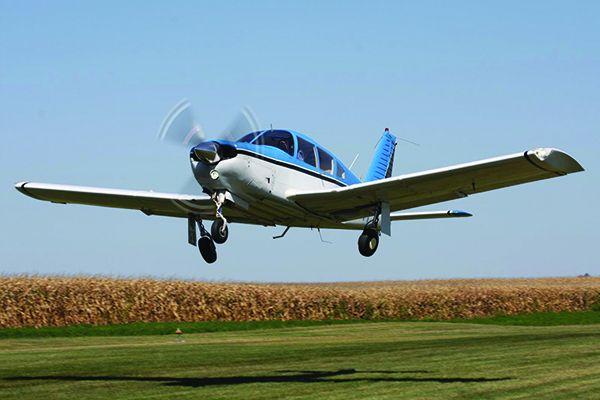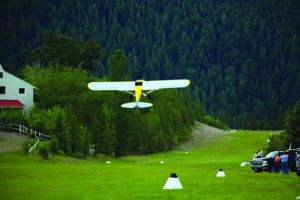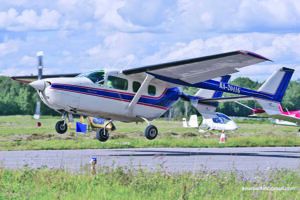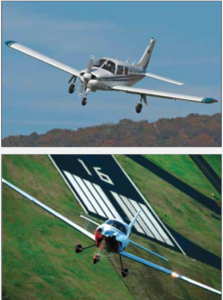
One of my fondest memories in aviation was the first flight I took in a Skyhawk. Even though my parents kept a kindergarten assignment where I said my goal in life was to be a pilot (after my career as an astronaut and a monster truck driver), I did not pursue aviation until after my first year of college. My neighbor was a pilot and it seemed like a neat idea, so I called the local airport. The next day I was ready to go, in the left seat of a Cessna 172 on a beautiful summer day.
One thing that surprised me at the time was how much I was allowed to do right off the bat. I was allowed to crank the starter, taxi out, even take off! Taking off is truly one of the joys of flying, and I think I was set down this path as soon as those wheels left the ground. In hindsight, the Certified Flight Instructor was assuredly right there on the controls with me through the whole thing. Still, how quickly was it before you were taking off without instructor assistance? For those instructors out there, when did you feel comfortable letting go of the reins with a new student during takeoff?
Takeoffs have some additional considerations, of course. I do not want to call them easy maneuvers per se, but when is the last time you needed to retrain in them? It surely occurs, but I have never heard of failing a check ride by exceeding standards on a takeoff. Additionally, takeoff emergencies are risky to practice. Certain events can be simulated, but any time the aircraft is low and slow, the options can be limited.
RISKY BUSINESS
Landings are the most hazardous phase of flight. Incidents and accidents occur most frequently during landings, which makes sense considering the circumstances. Every flight must end in a landing, and the intention is to force the airplane to fly onto the runway as smoothly as possible. Takeoffs rank second on the list, but the accidents are more frequently fatal. When assessing levels of risk, there are two factors: severity and likelihood. Landing accidents occur more frequently, but are less likely to be fatal, which lowers the severity level. Takeoff accidents are less likely but have a higher severity due to the increased chance of a fatal accident. Typically, fatal takeoff accidents are due to failed rejected takeoffs leading to overruns or controlled flight into terrain (CFIT). Additionally, loss-of-control accidents are common with full or partial engine failures during climb out.
There are a few aspects of takeoffs that benefit the pilot in risk reduction, and some that can push pilots toward complacency. For a typical mission, the takeoff is really the first major maneuver in any flight. Plane Taxiing, and especially runway crossings, do present hazards but the vast majority of incidents prior to takeoff do not result in injury or death. In other words, the pilot is still fresh during takeoff. Flying, especially in challenging conditions, can be exhausting. Additionally, until power is added and the aircraft is rolling down the runway, time is plentiful. Care can be taken to calculate takeoff data, analyze the airport and surrounding area and create a plan. On the other side of the coin, as discussed previously, takeoffs are fairly easy maneuvers. If the pilot starts rushing or succumbs to complacency, most of the time there will be no harm done. Maintaining discipline and remembering the potential hazards faced with every takeoff is important.

One thing general aviation has in abundance is rules of thumb. When considering takeoff performance, a useful one is the 50/70 Rule. It goes like this: If you haven’t reached 70 percent of your liftoff speed after using 50 percent of the runway, you should abort the attempt. The reason is simple math: The faster you roll, the more runway you eat up; the longer it takes to reach liftoff speed, the less and less of it is available.
There are two tricks to this. One is an accurate assessment of your desired liftoff speed, given the existing conditions, and correctly doing the math to come up with the 70-percent value. The other is a realistic determination of the runway’s midpoint.
If you’re unsure what your liftoff speed should be, consult the Aircraft Flight Manual/Pilots Operating Handbook and its takeoff performance data. Be sure to correct for atmospheric conditions.
Finding the runway’s midpoint is a lot easier. For example, big-airport runways have distance markers. Others are diagrammed in your Electronic Flight Bag’s data, the Chart Supplement or even a state aviation department’s airport directory. Use a convenient taxiway, hangar complex, terminal building, pine tree or other feature to mark the midpoint. You can even count the runway’s centerline stripes or lights and divide by two. — J.B.
PRIOR PROPER PLANNING
My instructor was very strict with takeoff and landing data when I was a student. Every day, even if it was a carbon copy of the day prior, I had to run all the numbers. Eventually I laminated a sheet and used dry-erase markers with the information and formulas, so that I only had to deal with information that changed. When your plane is always topped off, unless you or your instructors’ weights changed, it turns out your weight and balance is pretty consistent! With Electronic Flight Bags gaining so much prevalence and always adding new features, pilots should be more aware of their takeoff performance than ever.
Despite this, almost every time I am doing training or a flight review, I ask about the takeoff data and I get spotty answers. Most of my flying is done out of a 3300-foot-long runway, which is almost always sufficient for smaller General Aviation aircraft at sea level. That’s generally the answer I get. “Yeah, we definitely have the numbers,” or, “It always works on days like today.” Usually this is completely true. The benefit of knowing exactly how your flying machine is supposed to perform on any given day is important, however. The last thing any pilot wants is to be accelerating down the runway, feeling that something may be not right.
If you have an accurate ground-roll number in mind, you can have an idea of when it may be prudent to abort. Any pilot operating on a grass or gravel strip should be familiar with this. After some rain, there may be days where the aircraft cannot get up to liftoff speed. Setting a decision point, such as a tree or other feature, at which you will abort if you have not reached liftoff speed can be lifesaving.
As an alternative, consider using the 50/70 rule, outlined in the sidebar on page 13. Regardless, if some metric of your takeoff progress is not employed, it can be too easy to talk yourself into continuing, especially if the plane is stuck 5-10 knots below the desired speed. Seeing it edge so close to liftoff speed but not reaching it can be a deadly trap.
If your typical mission profile involves any additional risk factors, (high, hot, heavy and/or short runways are the typical suspects) it is critical to remain vigilant when monitoring takeoff data. Play around with some temperatures and altimeter settings at your field elevation in a density-altitude calculator. On some summer days, the density altitude can be three to four thousand above field elevation.
Last thing, and I promise I will stop talking about takeoff data: Ensure your Electronic Flight Bag has the data published in your Aircraft Flight Manual. The Electronic Flight Bags we have these days are fantastic, amazingly accurate tools, but the right profile must be selected.

Having two engines can solve many issues associated with an engine failure after liftoff. While the extra engine provides redundancy, it also adds some risk, however. For example, if you have an engine failure prior to liftoff in a single-engine airplane, it’s a simple maneuver and the decision to abort is made for you. In a conventional twin, if an engine fails prior to liftoff, close both throttles immediately to prevent a runway excursion.
With a conventional twin, the threat of VMC rollovers replaces the impossible turn (see the sidebar on the opposite page).
If it has been a while since you’ve practiced engine failures in your twin, it is worth reviewing the factors affecting VMC. I have seen a lot of discussion from multi-engine instructors about reducing power and landing straight ahead in the event of a twin losing an engine shortly after takeoff. It’s definitely a viable option, especially if the performance numbers are less than ideal, the pilot is less-than-proficient with engine-out procedures or, as is frequently the case, both are true.
PREVENTION IS THE BEST CURE
One of my favorite tools I rarely see mentioned in preflight planning is Google Maps or whatever is your favorite satellite imaging service provider. I know I keep bringing up my primary instructor, but quality instructors are like your flying conscious: They just stick with you. Every takeoff and climbout, he would ask, “Where are you going to land if you have an engine failure?…What about now?” Eventually I had spots picked out for every departure at our local airport. Unfortunately, it is not cost- nor time-effective to depart each runway and scout out ideal landing spots and hazardous terrain. Using satellite imaging is a great way to substitute this, especially when used in conjunction with the low altitude en route charts.
Much can be done to increase takeoff safety once you get to the airplane. A proper preflight and runup can unearth several issues that could ruin a perfectly good takeoff. Additionally, I am a proponent of takeoff briefings, even single-pilot. The Flight Safety Foundation promotes a useful acronym T(threats)-P(plan)-C(consideration) for effective, scalable briefings. Threats, such as weather, high-density traffic areas, airspace or fatigue are just a few examples of factors worth noting prior to any takeoff.
Planning involves normal and emergency operations. Normal operations would include any assigned departure procedures, Obstacle Departure Procedures or however you plan on transitioning from the runway to cruise. Emergencies depend vastly on your terrain, aircraft and airport environment. On long runways, for example, you may choose to delay retracting the gear. A safe altitude for an impossible turn will be different in a Cubcrafter than in a Mooney. Once you have a plan, stick with it. Considerations include anything non-standard and anything worth reemphasizing. A VFR departure procedure from a familiar airport will be substantially shorter than a complicated DP from a busy, unfamiliar airport.
The last-chance prevention measure takes place immediately before the takeoff. I always execute a static takeoff, instead of the rolling version, and announce, “Power set, gauges green.” Knowing what power output to expect can prevent an overrun or CFIT accident due to an underperforming engine. Full throttle is asking the most you ever will from an engine—and sometimes it’s too much. If anything feels off, trust your gut. Your subconscious may be picking up on something you are not seeing. Using a static takeoff may not seem like it will make much of a difference, but it allows you to fully analyze your instrumentation while sitting still and maximizes runway available for an aborted takeoff.

The AOPA Air Safety Institute recently released a video called Reality Check: The Runway Behind You. It was a great demonstration of how variable the decision to make an impossible turn is. A Piper J-3 Cub was able to make the turn back to the airport at 300 feet agl, whereas a Bonanza was not able to make it back to the runway after three attempts at 1000 feet.
The aircraft is only one factor. The impossible turn should only be attempted if the pilot is proficient and the maneuver is the safest option. If there is an empty, beautiful field right off the departure end, I would choose that 10 out of 10 times. Do not let the desire to save the aircraft skew your decision.
Meanwhile, the Experimental Aircraft Association (EAA) announced in October it had formed a team to explore ways of improving aviation safety by focusing on turns back to the runway following engine failure on takeoff. In addition to EAA staffers, the group will include the flight-instruction and flight-test communities, academia, data analysis experts and others.
Among its primary focus areas:
• Reacting to an engine failure at takeoff.
• Stall awareness, recognition, and prevention after loss of power in a takeoff attitude, and recovery.
• Teaching pilots proper judgment in this scenario, the ability of different types of aircraft to perform such a maneuver and whether a turnback is the appropriate response.
PRACTICE MAKES PERFECT
I mentioned earlier how challenging it is to practice engine-out procedures at low altitude. The best solution is to practice them at a safe altitude, simulating a takeoff. Enter slow flight at a specific altitude and add takeoff power. Pitch for VX or VY and pull the power back at various altitudes. Notice how quickly speed bleeds off. If you consider startle factor, it is easy to see how an engine failure after takeoff results in a stall/spin. The critical angle of attack approaches quickly, and the ground is getting too close. It must be a muscle memory reaction to reduce angle of attack. A controlled crash is substantially more survivable than a stall/spin. This method of attempting maneuvers at altitude can also be used to also practice turning back. It may become apparent that even 1000 feet of altitude, a common yardstick for turning back, will not work in all conditions. Best to find out it does not work with 3000 feet of altitude underneath you.
Takeoffs are one of the most enjoyable parts of flying. When those wheels depart the runway, and the ground gets further away, we’re reminded of why we went through the trouble of getting our ratings. It is key to stay vigilant during each and every takeoff, even while we are enjoying the view.
Ryan Motte is a Massachusetts-based Part 135 pilot, flight instructor and check airman. He moonlights as Director of Safety when he isn’t flying.



